Spatiotemporal Dynamics and Multi-Scenario Projections of the Land Use and Habitat Quality in the Yellow River Basin: A GeoDetector-PLUS-InVEST Integrated Framework for a Coupled Human–Natural System Analysis
Abstract
1. Introduction
2. Materials and Methods
2.1. Study Area
2.2. Datasets
2.2.1. Land Use/Cover Data
2.2.2. Climate Factor Datasets
2.2.3. Socio-Economic Data
2.2.4. Vegetation Remote Sensing Datasets
2.2.5. Geographic Data
2.3. Methods
2.3.1. Land Use Transfer Matrix
2.3.2. GeoDetector
2.3.3. Markov Chain
2.3.4. Patch-Generating Land Use Simulation (PLUS)
2.3.5. Habitat Quality Assessment (HQA) Based on InVEST Model
2.3.6. Anselin Local Moran’s I
2.3.7. Habitat Quality–Autocorrelated Coupling Index (HQACI)
3. Results
3.1. Characteristics of the Spatial and Temporal Evolution of LUCC in the YRB
3.1.1. Temporal Characteristics of LUCC
3.1.2. Spatial Characteristics of Land Use Transfer
3.2. Analysis of Driving Factors for LUCC
3.2.1. The Analysis of the Influence Factor Detector Results
3.2.2. Analysis of Interaction Detector Results
3.3. The Scenario Simulation of the LUCC in the Yellow River Basin
3.3.1. Scenario Simulation of LUCC in 2040
3.3.2. The Analysis of the Results of the LUCC from 2020 to 2040
3.3.3. The LUCC of Nine Provinces in the YRB Under the Scenario Simulation
3.4. Habitat Quality: Spatial Heterogeneity and Local Autocorrelation Analysis
3.4.1. Spatial Distribution Patterns and Classification of Habitat Quality
3.4.2. Local Spatial Autocorrelation Characteristics of Habitat Quality
3.4.3. Interplay Between Spatial Heterogeneity and Autocorrelation Patterns
4. Discussion
4.1. Characteristics of the Land Use Change in the Yellow River Basin
4.2. The Analysis of the Influencing Factors of the Land Use Change in the Yellow River Basin
4.3. Spatiotemporal Patterns and Adaptive Management of Habitat Quality Clustering
4.4. Policy Implications and Strategic Recommendations
- (1)
- Cross-Provincial Ecological Compensation: Align market incentives with conservation priorities in critical ecological zones like riparian corridors and headwaters, fostering interregional equity through compensation mechanisms;
- (2)
- Geomorphic Threshold-Based Zoning: Prohibit industrial activities in vulnerable areas while allowing sustainable agroforestry in transitional landscapes, balancing protection and development;
- (3)
- Integrated Basin Governance: Coordinate upstream–downstream responsibilities to prioritize sediment control, groundwater recharge, and wetland restoration, ensuring ecological resilience across scales. These strategies aim to reconcile historical policy imbalances by addressing scale mismatches and economic–ecological trade-offs and monitoring gaps, thereby fostering sustainable habitat quality trajectories across the basin.
4.5. Limitations of This Study
5. Conclusions
Author Contributions
Funding
Institutional Review Board Statement
Data Availability Statement
Conflicts of Interest
References
- IPCC. Climate Change 2021: The Physical Science Basis; Contribution of Working Group I to the Sixth Assessment Report of the Intergovernmental Panel on Climate Change; Cambridge University Press: Cambridge, UK, 2021. [Google Scholar]
- Tian, F.; Liu, L.-Z.; Yang, J.-H.; Wu, J.-J. Vegetation greening in more than 94% of the Yellow River Basin (YRB) region in China during the 21st century caused jointly by warming and anthropogenic activities. Ecol. Indic. 2021, 125, 107479. [Google Scholar] [CrossRef]
- Liu, J.; Zhang, Z.; Xu, X.; Kuang, W.; Zhou, W.; Zhang, S.; Li, R.; Yan, C.; Yu, D.; Wu, S.; et al. Spatial Patterns and Driving Forces of Land Use Change in China in the Early 21st Century. Acta Geogr. Sin. 2009, 64, 1411–1420. [Google Scholar] [CrossRef]
- Li, T.; Zhang, Q.; Wang, G.; Singh, V.P.; Zhao, J.; Sun, S.; Wang, D.; Liu, T.; Duan, L. Ecological degradation in the Inner Mongolia reach of the Yellow River Basin, China: Spatiotemporal patterns and driving factors. Ecol. Indic. 2023, 154, 110498. [Google Scholar] [CrossRef]
- NASA. Human Activity in China and India Dominates the Greening of Earth, NASA Study Shows. Available online: https://www.nasa.gov/feature/ames/human-activity-in-china-and-india-dominates-the-greening-of-earth-nasa-study-shows (accessed on 12 February 2019).
- Piao, S.; Wang, X.; Park, T.; Chen, C.; Lian, X.; He, Y.; Bjerke, J.W.; Chen, A.; Ciais, P.; Tømmervik, H.; et al. Characteristics, drivers and feedbacks of global greening. Nat. Rev. Earth Environ. 2020, 1, 14–27. [Google Scholar] [CrossRef]
- Yang, Y.; Roderick, M.L.; Guo, H.; Miralles, D.G.; Zhang, L.; Fatichi, S.; Luo, X.; Zhang, Y.; McVicar, T.R.; Tu, Z.; et al. Evapotranspiration on a greening Earth. Nat. Rev. Earth Environ. 2023, 4, 626–641. [Google Scholar] [CrossRef]
- Gou, Y.; Tao, Y.; Kou, P.; Alonso, A.; Luo, X.; Tian, H. Elucidate the complex drivers of significant greening on the Loess Plateau from 2000 to 2020. Environ. Dev. 2024, 50, 100991. [Google Scholar] [CrossRef]
- Ji, X.; Sun, Y.; Guo, W.; Zhao, C.; Li, K. Land use and habitat quality change in the Yellow River Basin: A perspective with different CMIP6-based scenarios and multiple scales. J. Environ. Manag. 2023, 345, 14. [Google Scholar] [CrossRef]
- Li, J.; Xi, M.; Wang, L.; Li, N.; Wang, H.; Qin, F. Vegetation Responses to Climate Change and Anthropogenic Activity in China, 1982 to 2018. Int. J. Environ. Res. Public Health 2022, 19, 7391. [Google Scholar] [CrossRef]
- Zhou, G.; Long, H. Explanation of land-use system evolution: Modes, trends, and mechanisms. Land Use Policy 2025, 150, 107470. [Google Scholar] [CrossRef]
- Zhou, J.; Yang, J.; Tang, Z.; Xue, L.; Zhang, W.; Zhang, J. Driving mechanisms of ecosystem services and their trade-offs and synergies in the transition zone between the Qinghai-Tibet Plateau and the Loess Plateau. Ecol. Indic. 2025, 171, 113148. [Google Scholar] [CrossRef]
- Nyland, K.E.; Gunn, G.E.; Shiklomanov, N.I.; Engstrom, R.N.; Streletskiy, D.A. Land Cover Change in the Lower Yenisei River Using Dense Stacking of Landsat Imagery in Google Earth Engine. Remote Sens. 2018, 10, 1226. [Google Scholar] [CrossRef]
- Kindu, M.; Schneider, T.; Teketay, D.; Knoke, T. Drivers of land use/land cover changes in Munessa-Shashemene landscape of the south-central highlands of Ethiopia. Environ. Monit. Assess. 2015, 187, 1–17. [Google Scholar] [CrossRef] [PubMed]
- Kou, P.; Xu, Q.; Jin, Z.; Yunus, A.P.; Luo, X.; Liu, M. Complex anthropogenic interaction on vegetation greening in the Chinese Loess Plateau. Sci. Total Environ. 2021, 778, 146065. [Google Scholar] [CrossRef] [PubMed]
- Lin, X.; Jiao, X.; Tian, Z.; Sun, Q.; Zhang, Y.; Zhang, P.; Ji, Z.; Chen, L.; Lun, F.; Chang, X.; et al. Projecting Diversity Conflicts of Future Land System Pathways in China Under Anthropogenic and Climate Forcing. Earth’s Future 2023, 11, e2022EF003406. [Google Scholar] [CrossRef]
- Winkler, K.; Fuchs, R.; Rounsevell, M.; Herold, M. Global land use changes are four times greater than previously estimated. Nat. Commun. 2021, 12, 2501. [Google Scholar] [CrossRef]
- Chen, S.; Yan, J.; Wang, Y.; Chang, Z.; Yu, G.; Li, J.; Jiang, J.; Wang, L.; Zhang, S.; Chen, Y.; et al. Analysis of Spatio-Temporal Relationship Between Ecosystem Services and Human Footprints Under Different Human Activity Gradients: A Case Study of Xiangjiang River Basin. Remote Sens. 2024, 16, 4212. [Google Scholar] [CrossRef]
- Li, Y.; Qin, Y.; Rong, P. Evolution of potential evapotranspiration and its sensitivity to climate change based on the Thornthwaite, Hargreaves, and Penman–Monteith equation in environmental sensitive areas of China. Atmos. Res. 2022, 273, 106178. [Google Scholar] [CrossRef]
- Qian, L.; Yu, X.; Wu, L.; Zhang, Z.; Fan, S.; Du, R.; Liu, X.; Yang, Q.; Qiu, R.; Cui, Y.; et al. Improving high uncertainty of evapotranspiration products under extreme climatic conditions based on deep learning and ERA5 reanalysis data. J. Hydrol. 2024, 641, 131755. [Google Scholar] [CrossRef]
- Chen, J.; Liu, M.; Chen, X.; Li, Z. Spatio-temporal evolution, driving mechanisms, and simulation of land use and cover in China from 2000 to 2060. Appl. Spat. Anal. Policy 2024, 17, 1631–1652. [Google Scholar] [CrossRef]
- Li, X.; Chen, Y. Projecting the future impacts of China’s cropland balance policy on ecosystem services under the shared socioeconomic pathways. J. Clean. Prod. 2020, 250, 119489. [Google Scholar] [CrossRef]
- Xu, D.; Yu, C.; Lin, W.; Yao, J.; Zhou, W. Spatiotemporal Evolution and Prediction of Land Use and Carbon Stock in Shanghai. Land 2024, 13, 267. [Google Scholar] [CrossRef]
- Zhao, X.; Miao, C. Spatial-Temporal Changes and Simulation of Land Use in Metropolitan Areas: A Case of the Zhengzhou Metropolitan Area, China. Int. J. Environ. Res. Public Health 2022, 19, 14089. [Google Scholar] [CrossRef] [PubMed]
- Yang, Y.; Yu, C.; Liu, M.; Wei, H. Uncovering the coupling relationships and key factors linking ecosystem services to human well-being through system dynamics: A case study in the Qinghai-Tibet Plateau. Ecol. Indic. 2024, 166, 112408. [Google Scholar] [CrossRef]
- Ouyang, Z.; Zheng, H.; Xiao, Y.; Polasky, S.; Daily, G.C. Improvements in ecosystem services from investments in natural capital. Science 2016, 352, 1455–1459. [Google Scholar] [CrossRef]
- Kuang, X.X.; Jiao, J.J. Review on climate change on the Tibetan Plateau during the last half century. J. Geophys. Res.-Atmos. 2016, 121, 3979–4007. [Google Scholar] [CrossRef]
- Xiao, J.; Zhang, Y.; Xu, H. Response of ecosystem service values to land use change, 2002–2021. Ecol. Indic. 2024, 160, 111947. [Google Scholar] [CrossRef]
- Zou, Z.; Yuan, X.; Zhang, Z.; Li, X.; Zhou, C. Spatiotemporal Evolution and Influencing Factors of Coupling and Coordination between the Ecosystem Service Value and Economy in the Pearl River Delta Urban Agglomeration of China. Land 2024, 13, 1670. [Google Scholar] [CrossRef]
- Sang, L.; Zhang, C.; Yang, J.; Zhu, D.; Yun, W. Simulation of land use spatial pattern of towns and villages based on CA–Markov model. Math. Comput. Model. 2011, 54, 938–943. [Google Scholar] [CrossRef]
- Zhang, M.; Chen, E.; Zhang, C.; Liu, C.; Li, J. Multi-scenario simulation of land use change and ecosystem service value based on the markov–FLUS model in Ezhou city, China. Sustainability 2024, 16, 6237. [Google Scholar] [CrossRef]
- Chen, Y.Q.; Zhang, F.Y.; Lin, J.Y. Projecting Future Land Use Evolution and Its Effect on Spatiotemporal Patterns of Habitat Quality in China. Appl. Sci. 2025, 15, 1042. [Google Scholar] [CrossRef]
- Chen, Y.L.; He, Z.L.; Yue, T.M.; Mu, W.C.; Qin, F. Spatiotemporal evolution and multi-scenario prediction of habitat quality in the Yellow River Basin. Front. Ecol. Evol. 2023, 11, 1226676. [Google Scholar] [CrossRef]
- Wang, X.; Liu, B.; Chen, J.Z.; Arash, M.; Zhang, B.; Chang, Q.; Liu, J.; You, W.X. Assessing the impact of land use change on habitat quality in Zhongwei through multiscenario simulation using the PLUS and InVEST models. Sci. Rep. 2025, 15, 12355. [Google Scholar] [CrossRef] [PubMed]
- Meng, R.; Cai, J.; Xin, H.; Meng, Z.; Dang, X.; Han, Y. Spatio-Temporal Changes in Land Use and Habitat Quality of Hobq Desert along the Yellow River Section. Int. J. Environ. Res. Public Health 2023, 20, 3599. [Google Scholar] [CrossRef]
- Li, Y.; Xie, Z.; Qin, Y.; Zheng, Z. Estimating Relations of Vegetation, Climate Change, and Human Activity: A Case Study in the 400 mm Annual Precipitation Fluctuation Zone, China. Remote Sens. 2019, 11, 1159. [Google Scholar] [CrossRef]
- Li, J.; Xi, M.; Pan, Z.; Liu, Z.; He, Z.; Qin, F. Response of NDVI and SIF to Meteorological Drought in the Yellow River Basin from 2001 to 2020. Water 2022, 14, 2978. [Google Scholar] [CrossRef]
- Li, J.; Qin, F.; Wang, Y.; Zhao, X.; Yu, M.; Chen, S.; Jiang, J.; Wang, L.; Yan, J. Spatiotemporal Variation of Water Use Efficiency and Its Responses to Climate Change in the Yellow River Basin from 1982 to 2018. Remote Sens. 2025, 17, 316. [Google Scholar] [CrossRef]
- Guo, X.; Zhang, H.; Wu, Z.; Zhao, J.; Zhang, Z. Comparison and Evaluation of Annual NDVI Time Series in China Derived from the NOAA AVHRR LTDR and Terra MODIS MOD13C1 Products. Sensors 2017, 17, 1298. [Google Scholar] [CrossRef]
- Chen, T.; Tang, G.; Yuan, Y.; Guo, H.; Xu, Z.; Jiang, G.; Chen, X. Unraveling the relative impacts of climate change and human activities on grassland productivity in Central Asia over last three decades. Sci. Total Environ. 2020, 743, 140649. [Google Scholar] [CrossRef]
- Zhang, Y.; Jiang, X.; Lei, Y.; Gao, S. The contributions of natural and anthropogenic factors to NDVI variations on the Loess Plateau in China during 2000–2020. Ecol. Indic. 2022, 143, 109342. [Google Scholar] [CrossRef]
- Zhang, X.Y.; Liu, K.; Li, X.K.; Wang, S.D.; Wang, J.N.A. Vulnerability assessment and its driving forces in terms of NDVI and GPP over the Loess Plateau, China. Phys. Chem. Earth 2022, 125, 103106. [Google Scholar] [CrossRef]
- Ru, X.; Qiao, L.; Zhang, H.; Bai, T.; Min, R.; Wang, Y.; Wang, Q.; Song, H. Effects of land use and land cover change under shared socioeconomic pathways on future climate in the Yellow River basin, China. Urban Clim. 2024, 55, 101867. [Google Scholar] [CrossRef]
- Wang, H.; Qin, F.; Xu, C.; Li, B.; Guo, L.; Wang, Z. Evaluating the suitability of urban development land with a Geodetector. Ecol. Indic. 2021, 123, 107339. [Google Scholar] [CrossRef]
- Hamad, R.; Balzter, H.; Kolo, K. Predicting land use/land cover changes using a CA-Markov model under two different scenarios. Sustainability 2018, 10, 3421. [Google Scholar] [CrossRef]
- Subedi, P.; Subedi, K.; Thapa, B. Application of a hybrid cellular automaton–Markov (CA-Markov) model in land-use change prediction: A case study of Saddle Creek Drainage Basin, Florida. Appl. Ecol. Environ. Sci. 2013, 1, 126–132. [Google Scholar] [CrossRef]
- Liang, X.; Guan, Q.; Clarke, K.C.; Liu, S.; Wang, B.; Yao, Y. Understanding the drivers of sustainable land expansion using a patch-generating land use simulation (PLUS) model: A case study in Wuhan, China. Comput. Environ. Urban Syst. 2021, 85, 101569. [Google Scholar] [CrossRef]
- Xu, L.; Liu, X.; Tong, D.; Liu, Z.; Yin, L.; Zheng, W. Forecasting urban land use change based on cellular automata and the PLUS model. Land 2022, 11, 652. [Google Scholar] [CrossRef]
- Feng, Z.; Zhang, P. “Grain for Green” Policy and Its Impacts on Grain Supply in West China. In China’s West Region Development; The University of Chicago Press: Chicago, IL, USA, 2004; pp. 291–307. [Google Scholar]
- Liu, Y.; Yuan, L. Evolution of water-use efficiency in the Yangtze River Economic Belt based on national strategies and water environment treatment. Ecol. Inform. 2022, 69, 101642. [Google Scholar] [CrossRef]
- Niu, H.; Xiu, Z.; Xiao, D. Impact of land-use change on ecological vulnerability in the Yellow River Basin based on a complex network model. Ecol. Indic. 2024, 166, 112212. [Google Scholar] [CrossRef]
- Yang, R.; Chen, H.; Chen, S.; Ye, Y. Spatiotemporal evolution and prediction of land use/land cover changes and ecosystem service variation in the Yellow River Basin, China. Ecol. Indic. 2022, 145, 109579. [Google Scholar] [CrossRef]
- Zhao, X.; Miao, C. Research on the Spatial Pattern of the Logistics Industry Based on POI Data: A Case Study of Zhengzhou City. Sustainability 2023, 15, 15574. [Google Scholar] [CrossRef]
- Yang, H.; Zhong, X.; Deng, S.; Nie, S. Impact of LUCC on landscape pattern in the Yangtze River Basin during 2001–2019. Ecol. Inform. 2022, 69, 101631. [Google Scholar] [CrossRef]
- Rodrigo-Comino, J.; Cambronero, L.; Gonzalez-Moreno, M.T.; Keesstra, S.D.; Vivar, J.G.; Cerda, A.; Senciales, J.M. Chapter 2—Sustainable development and integrated soil management: Tools and keys for surveying the landscape evolution and degradation processes in Mediterranean mountainous regions. In Environmental Sustainability and Global Change; Salvati, L., Ed.; Elsevier: London, UK, 2025; pp. 19–31. [Google Scholar]
- Du, L.; Dong, C.; Kang, X.; Qian, X.; Gu, L. Spatiotemporal evolution of land cover changes and landscape ecological risk assessment in the Yellow River Basin, 2015–2020. J. Environ. Manag. 2023, 332, 117149. [Google Scholar] [CrossRef] [PubMed]
- Song, Y.; Wang, M.; Sun, X.; Fan, Z. Quantitative assessment of the habitat quality dynamics in Yellow River Basin, China. Environ. Monit. Assess. 2021, 193, 614. [Google Scholar] [CrossRef] [PubMed]
- An, X. Responses of Water Use Efficiency to climate change in evapotranspiration and transpiration ecosystems. Ecol. Indic. 2022, 141, 109157. [Google Scholar] [CrossRef]
- Cai, L.; Fan, D.; Wen, X.; Wang, H.; Badarifu; Wang, S. Spatiotemporal tendency of agricultural water use efficiency in the northernmost Yellow River: Indicator comparison and interactive driving factors. J. Arid Environ. 2022, 205, 104822. [Google Scholar] [CrossRef]
- Du, Q.; Sun, Y.; Guan, Q.; Pan, N.; Wang, Q.; Ma, Y.; Li, H.; Liang, L. Vulnerability of grassland ecosystems to climate change in the Qilian Mountains, northwest China. J. Hydrol. 2022, 612, 128305. [Google Scholar] [CrossRef]
- Li, F.; Wu, S.; Liu, H.; Yan, D. Biodiversity loss through cropland displacement for urban expansion in China. Sci. Total Environ. 2024, 907, 167988. [Google Scholar] [CrossRef]
- Xu, Y.; Lu, Y.-G.; Zou, B.; Xu, M.; Feng, Y.-X. Unraveling the enigma of NPP variation in Chinese vegetation ecosystems: The interplay of climate change and land use change. Sci. Total Environ. 2024, 912, 169023. [Google Scholar] [CrossRef]
- Zhang, L.; Deng, C.; Kang, R.; Yin, H.; Xu, T.; Kaufmann, H.J. Assessing the responses of ecosystem patterns, structures and functions to drought under climate change in the Yellow River Basin, China. Sci. Total Environ. 2024, 929, 172603. [Google Scholar] [CrossRef]
- Zhang, S.; Yang, D.; Jayawardena, A.W.; Xu, X.; Yang, H. Hydrological change driven by human activities and climate variation and its spatial variability in Huaihe Basin, China. Hydrol. Sci. J. 2016, 61, 1370–1382. [Google Scholar] [CrossRef]
- Hao, Z.C.; Singh, V.P. Drought characterization from a multivariate perspective: A review. J. Hydrol. 2015, 527, 668–678. [Google Scholar] [CrossRef]
- Liu, L.Z.; Yang, X.; Zhou, H.K.; Liu, S.S.; Zhou, L.; Li, X.H.; Yang, J.H.; Han, X.Y.; Wu, J.J. Evaluating the utility of solar-induced chlorophyll fluorescence for drought monitoring by comparison with NDVI derived from wheat canopy. Sci. Total Environ. 2018, 625, 1208–1217. [Google Scholar] [CrossRef] [PubMed]
- Deng, G.; Jiang, H.; Zhu, S.; Wen, Y.; He, C.; Wang, X.; Sheng, L.; Guo, Y.; Cao, Y. Projecting the response of ecological risk to land use/land cover change in ecologically fragile regions. Sci. Total Environ. 2024, 914, 169908. [Google Scholar] [CrossRef]
- Ji, R.; Wang, C.; Wang, P.; Wang, W.; Chen, N. Quantitative analysis of spatiotemporal disparity of urban water use efficiency and its driving factors in the Yangtze River Economic Belt, China. J. Hydrol. Reg. Stud. 2024, 51, 101647. [Google Scholar] [CrossRef]
- Ren, D.-F.; Cao, A.-H.; Wang, F.-Y. Response and Multi-Scenario Prediction of Carbon Storage and Habitat Quality to Land Use in Liaoning Province, China. Sustainability 2023, 15, 4500. [Google Scholar] [CrossRef]
- Liu, X.; Lai, Q.; Yin, S.; Bao, Y.; Tong, S.; Adiya, Z.; Sanjjav, A.; Gao, R. Spatio-temporal patterns and control mechanism of the ecosystem carbon use efficiency across the Mongolian Plateau. Sci. Total Environ. 2024, 907, 167883. [Google Scholar] [CrossRef]
- Tian, J.; Feng, C.; Fu, G.; Fan, L.; Wang, W. Contribution of different types of terrestrial protected areas to carbon sequestration services in China: 1980–2020. Front. Ecol. Evol. 2023, 11, 1074410. [Google Scholar] [CrossRef]
- Liu, Q.; Gan, L.; Wu, J.; Zhou, J.; Li, S.; Wu, H.; Wang, B.; Liang, L.; Yan, D. Deviation of hydrological regimes caused by blockage of hydrological connectivity: Implications for wetland restoration and management. CATENA 2025, 255, 109025. [Google Scholar] [CrossRef]
- Rinaldo, A.; Rodriguez-Iturbe, I. Ecohydrology 2.0. Rend. Lincei. Sci. Fis. Nat. 2022, 33, 245–270. [Google Scholar] [CrossRef]
- Shi, F.; Liu, S.; An, Y.; Sun, Y.; Zhao, S.; Liu, Y.; Li, M. Spatio-Temporal Dynamics of Landscape Connectivity and Ecological Network Construction in Long Yangxia Basin at the Upper Yellow River. Land 2020, 9, 265. [Google Scholar] [CrossRef]
- Rinnan, D.S.; Sica, Y.; Ranipeta, A.; Wilshire, J.; Jetz, W. Multi-scale planning helps resolve global conservation needs with regional priorities. bioRxiv 2021, 2020.2002.2005.936047. [Google Scholar] [CrossRef]
- Wang, S.; Liu, Z.; Chen, Y.; Fang, C. Factors influencing ecosystem services in the Pearl River Delta, China: Spatiotemporal differentiation and varying importance. Resour. Conserv. Recycl. 2021, 168, 105477. [Google Scholar] [CrossRef]
- Rahman, I.U.; Afzal, A.; Iqbal, Z.; Hashem, A.; Al-Arjani, A.-B.F.; Alqarawi, A.A.; Abd_Allah, E.F.; Abdalla, M.; Calixto, E.S.; Sakhi, S.; et al. Species Distribution Pattern and Their Contribution in Plant Community Assembly in Response to Ecological Gradients of the Ecotonal Zone in the Himalayan Region. Plants 2021, 10, 2372. [Google Scholar] [CrossRef] [PubMed]
- Dahal, K. Peri-urban Development: Discussion with Land Use Zoning, Statutory Provision, and Issues inside Katahari Rural Municipality, Nepal. J. Geogr. Res. 2023, 6, 1–16. [Google Scholar] [CrossRef]
- McDowell, N.G.; Coops, N.C.; Beck, P.S.; Chambers, J.Q.; Gangodagamage, C.; Hicke, J.A.; Huang, C.Y.; Kennedy, R.; Krofcheck, D.J.; Litvak, M.; et al. Global satellite monitoring of climate-induced vegetation disturbances. Trends Plant Sci. 2015, 20, 114–123. [Google Scholar] [CrossRef]
- Naeem, S.; Zhang, Y.; Zhang, X.; Rehman, A.U.; Tang, Z.; Xu, Z.; Li, C.; Azeem, T. Recent change in ecosystem water use efficiency in China mainly dominated by vegetation greening and increased CO2. Remote Sens. Environ. 2023, 298, 113811. [Google Scholar] [CrossRef]
- Yu, L.; Zhao, X.; Gao, X.; Jia, R.; Yang, M.; Yang, X.; Wu, Y.; Siddique, K.H.M. Effect of natural factors and management practices on agricultural water use efficiency under drought: A meta-analysis of global drylands. J. Hydrol. 2021, 594, 125977. [Google Scholar] [CrossRef]
- Chen, S.; Xiong, L.; Ma, Q.; Kim, J.-S.; Chen, J.; Xu, C.-Y. Improving daily spatial precipitation estimates by merging gauge observation with multiple satellite-based precipitation products based on the geographically weighted ridge regression method. J. Hydrol. 2020, 589, 125156. [Google Scholar] [CrossRef]
- Zhang, Y.; Kong, D.; Gan, R.; Chiew, F.H.S.; McVicar, T.R.; Zhang, Q.; Yang, Y. Coupled estimation of 500 m and 8-day resolution global evapotranspiration and gross primary production in 2002–2017. Remote Sens. Environ. 2019, 222, 165–182. [Google Scholar] [CrossRef]

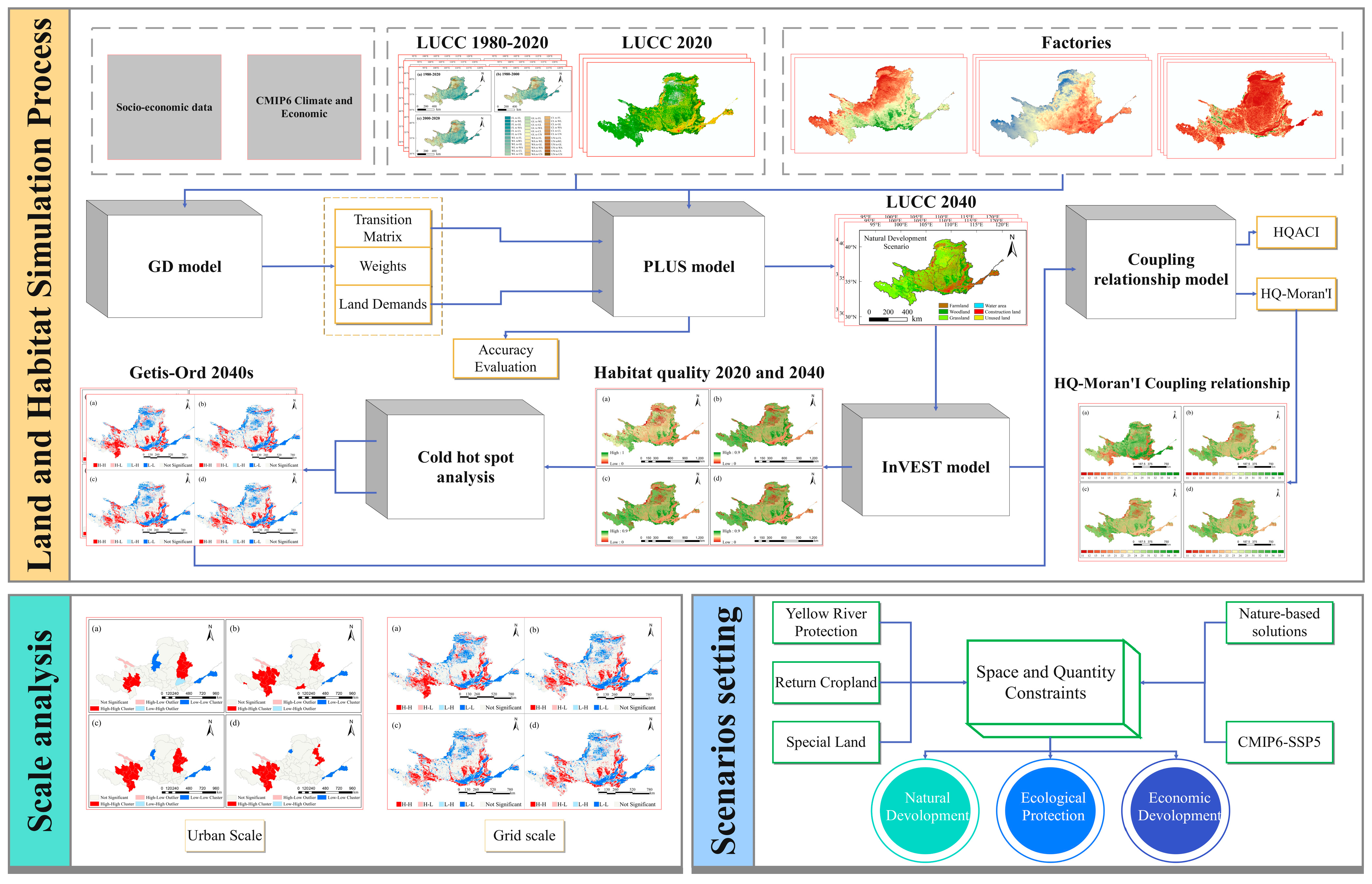

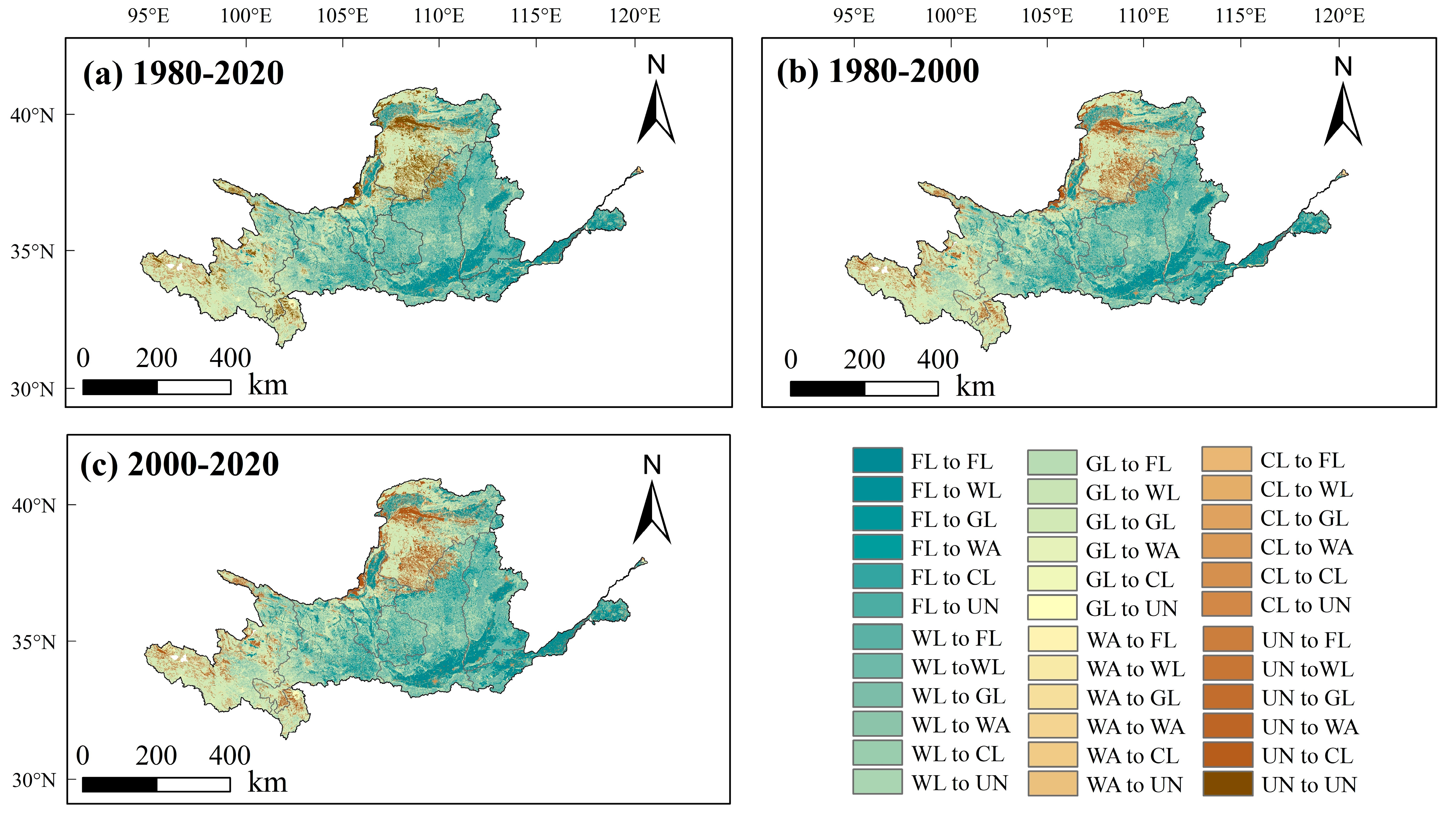

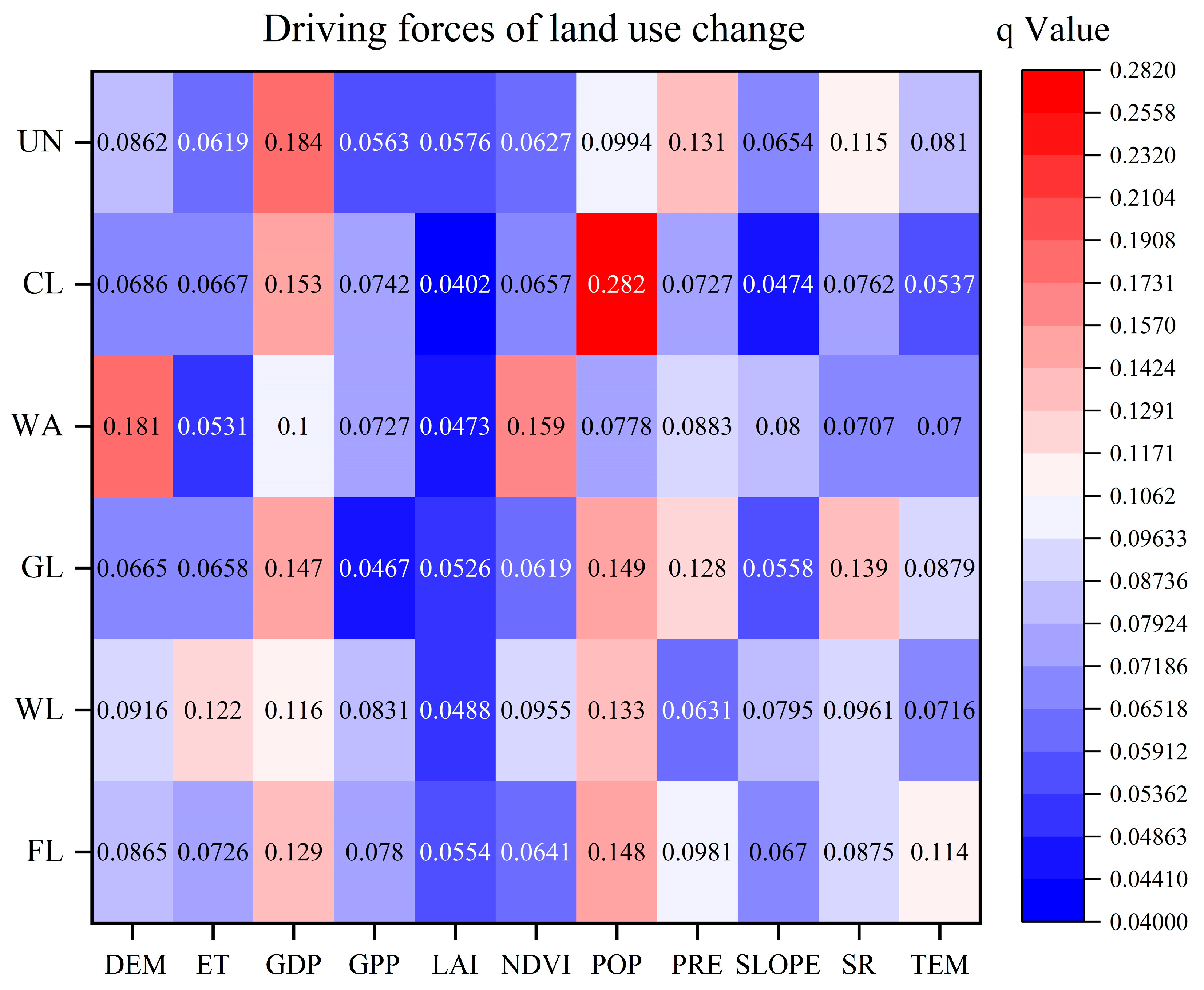
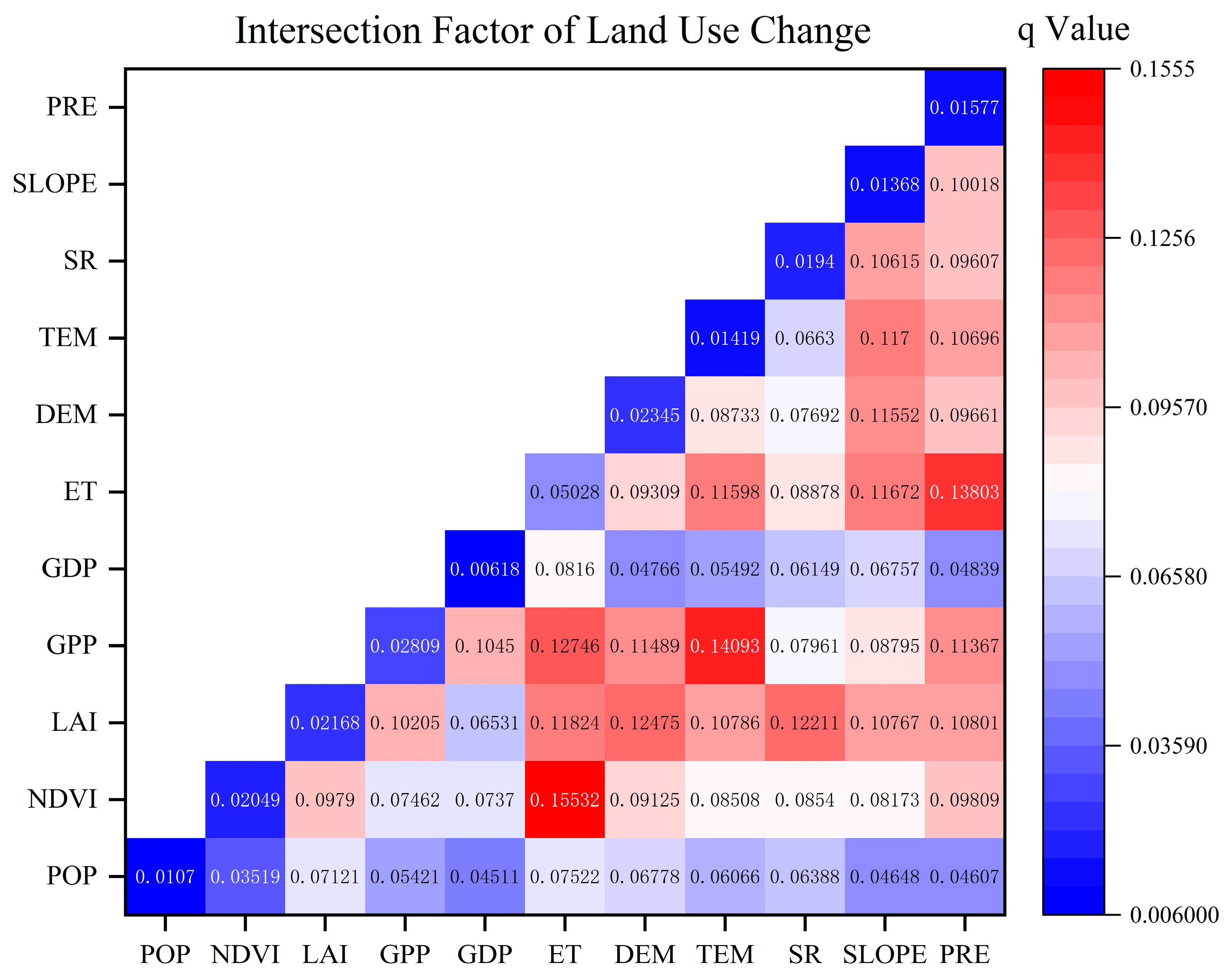
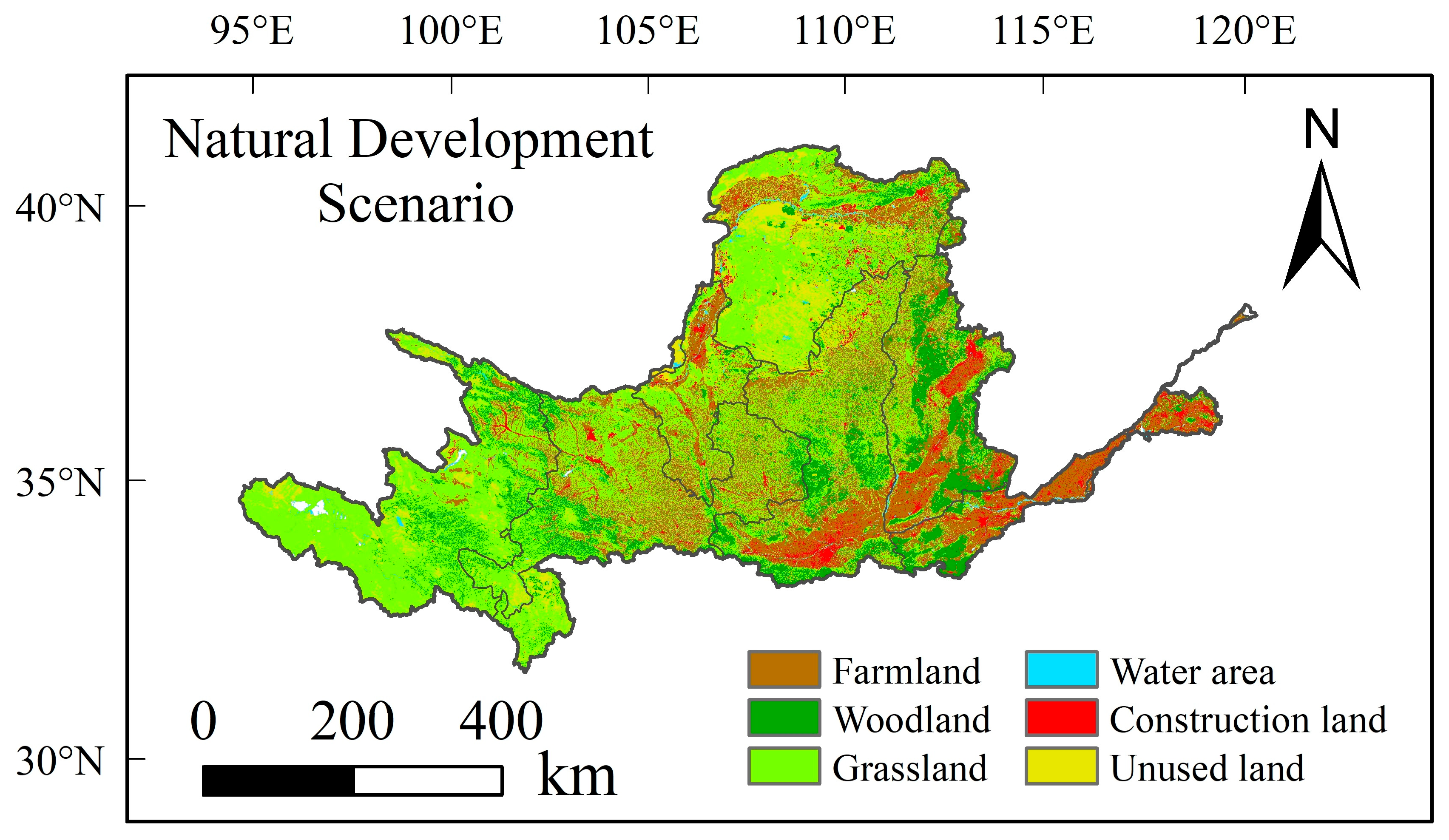



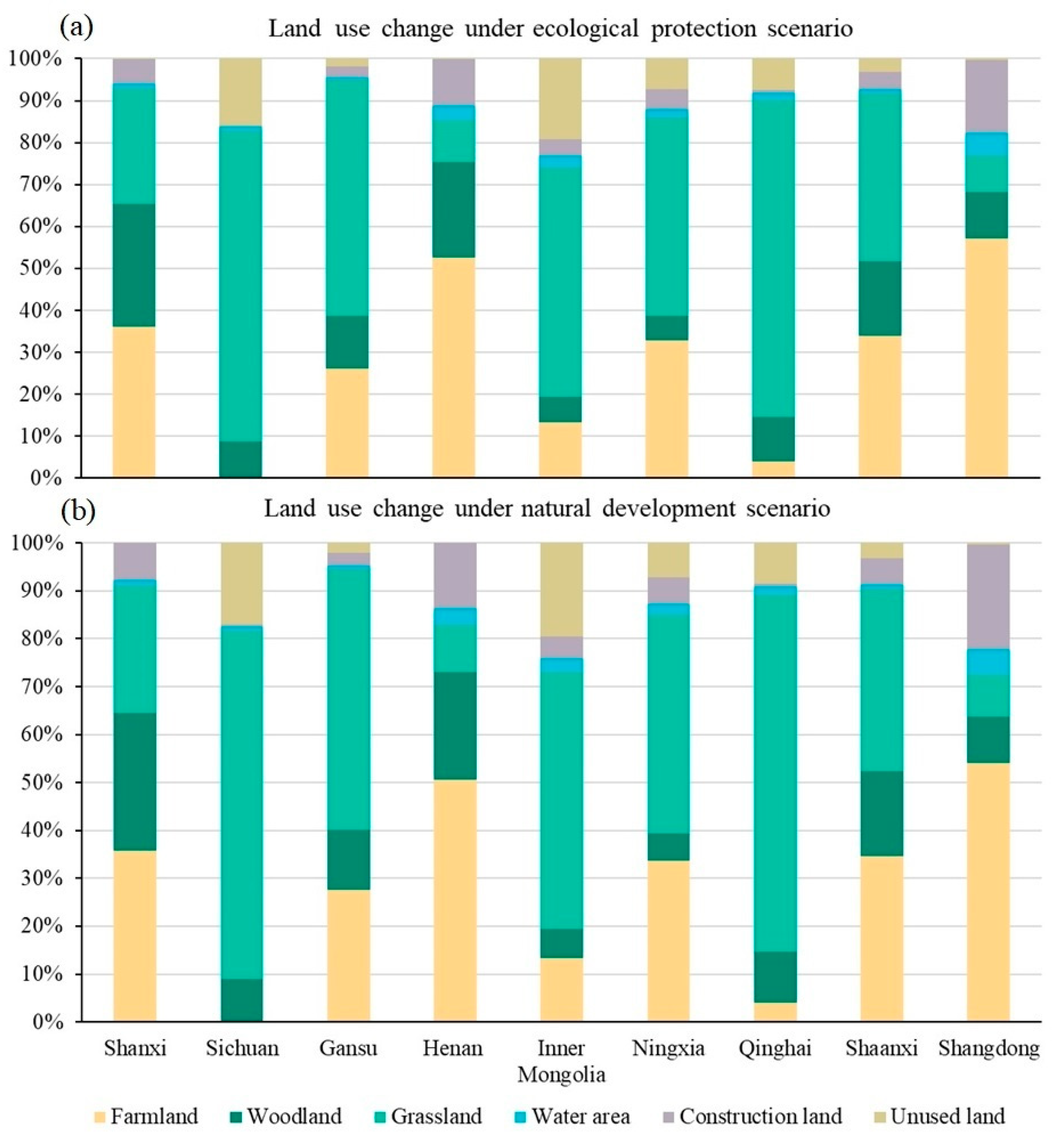
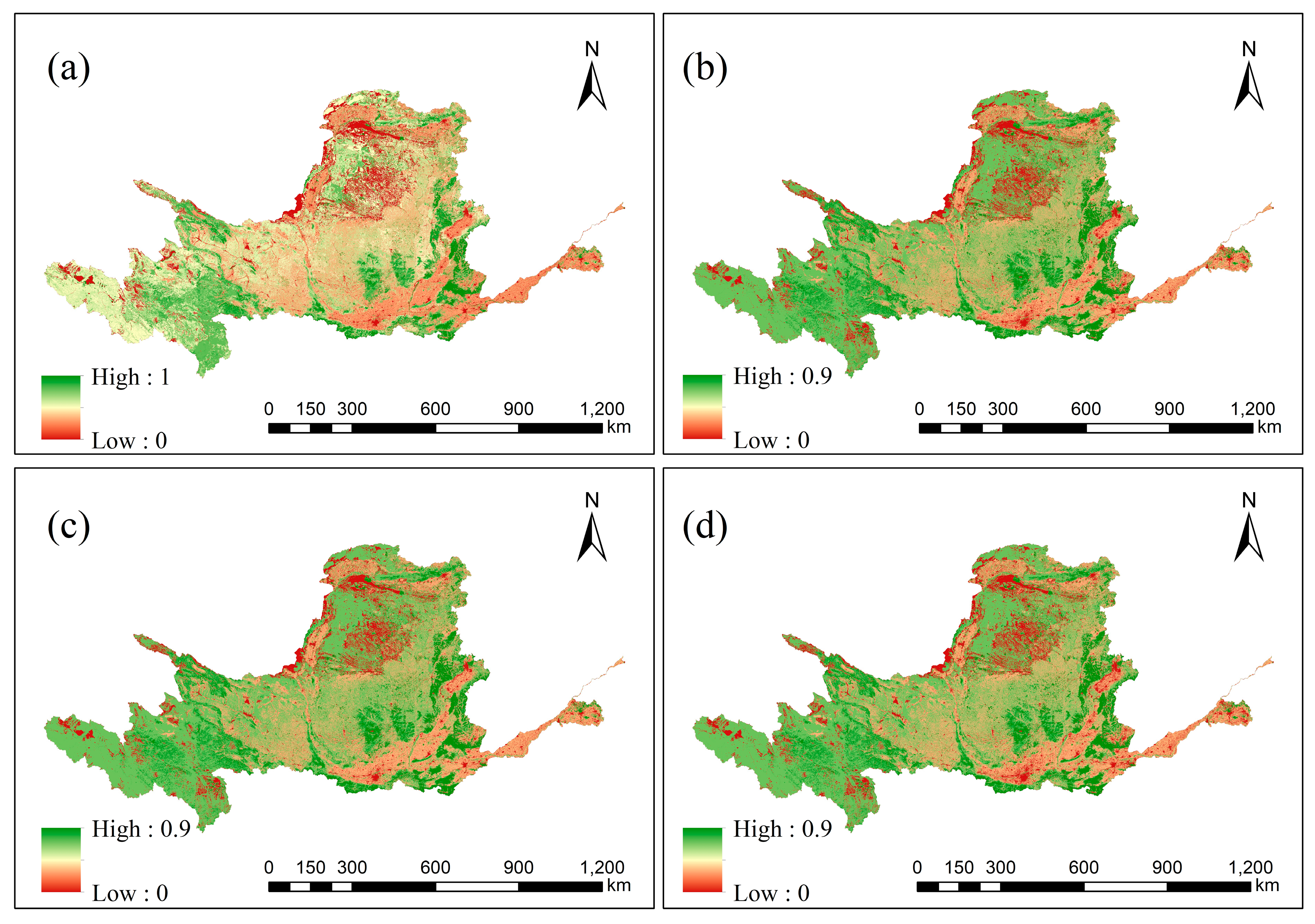
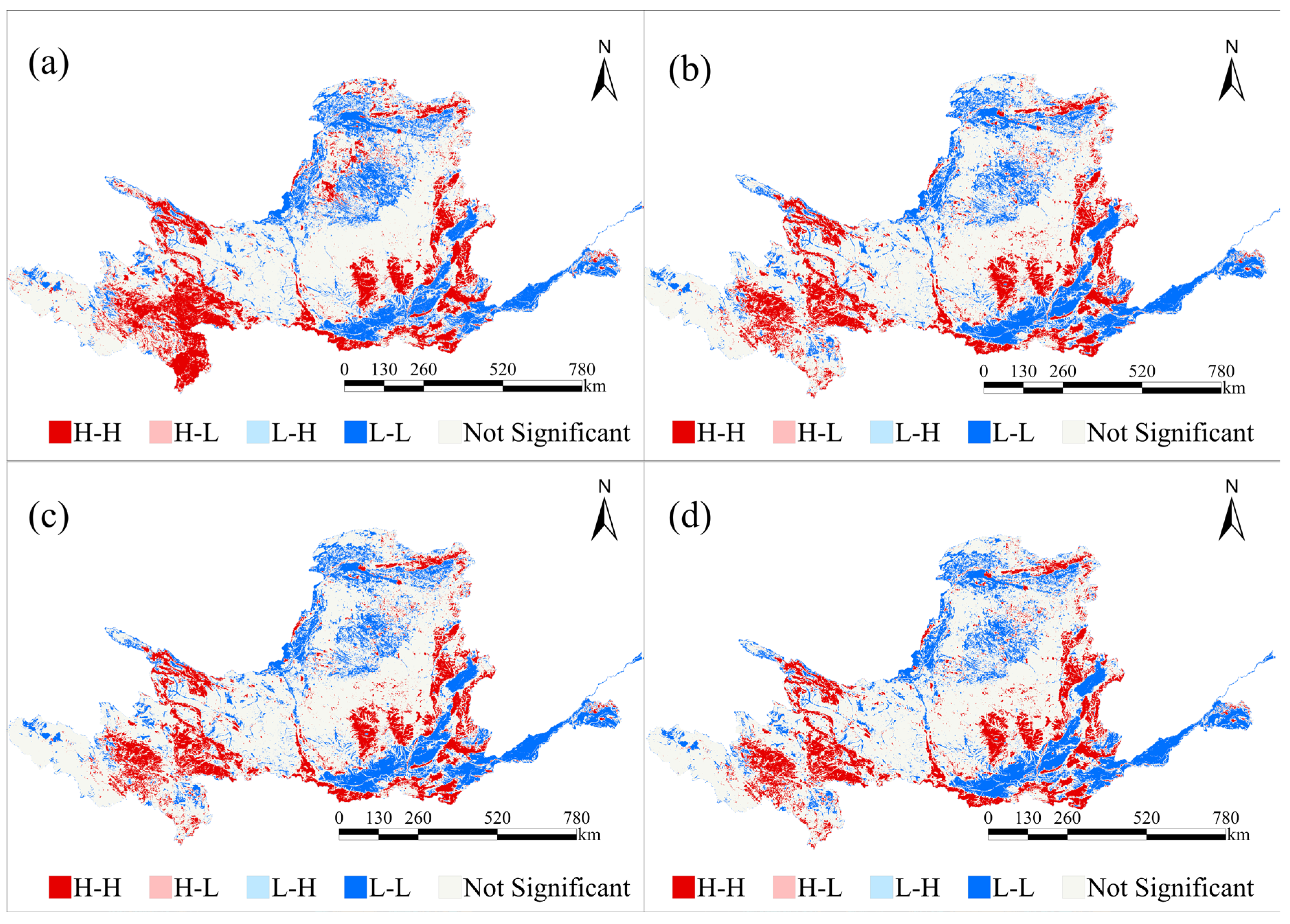

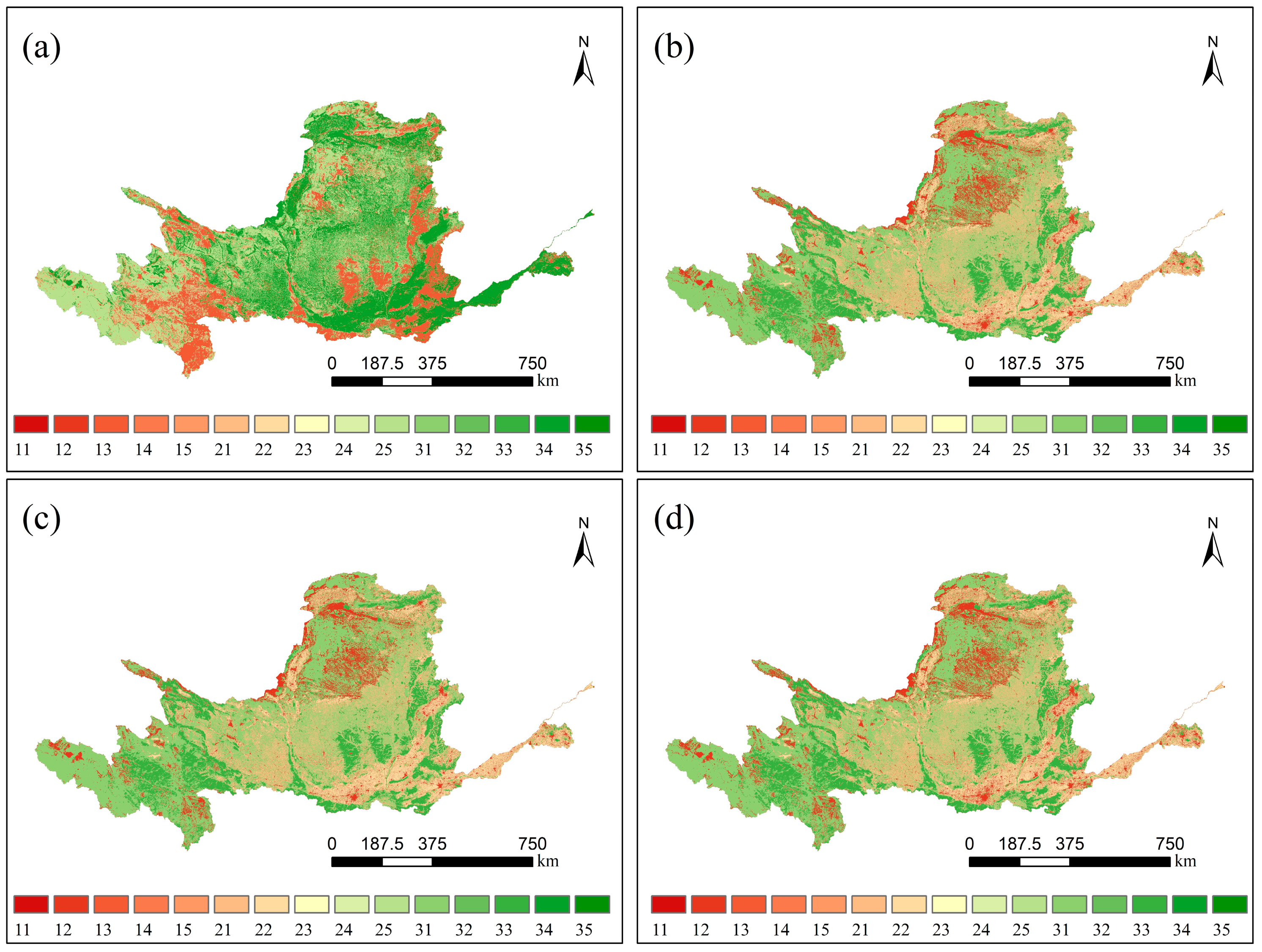

| Year | Area (km2) | 2020 | ||||||
|---|---|---|---|---|---|---|---|---|
| FL | WL | GL | WA | CL | UN | Transfer out | ||
| 1980 | FL | 122,348.43 | 11,762.12 | 54,551.36 | 2877.81 | 15,559.84 | 1691.06 | 86,442.19 |
| WL | 9762.72 | 65,405.71 | 26,088.61 | 400.90 | 955.65 | 725.20 | 37,933.09 | |
| GL | 53,286.73 | 27,710.10 | 275,461.60 | 3205.30 | 5284.50 | 17,984.40 | 107,471.02 | |
| WA | 3436.39 | 501.13 | 2796.10 | 5065.53 | 625.61 | 986.29 | 8345.52 | |
| CL | 7769.07 | 417.50 | 1875.56 | 268.12 | 5122.99 | 164.06 | 10,494.30 | |
| UN | 2445.63 | 1283.78 | 24,008.14 | 1060.35 | 1010.55 | 39,490.09 | 29,808.45 | |
| Transfer in | −9747.98 | 3737.68 | 1824.47 | −536.87 | 12,941.77 | −8261.20 | — | |
| Land Type | Natural Development Scenario | Ecological Protection Scenario | Economic Development Scenario | |||
|---|---|---|---|---|---|---|
| Area | Proportion | Area | Proportion | Area | Proportion | |
| Farmland | 189,774.9 | 23.77% | 187,559.37 | 23.50% | 188,342.325 | 23.93% |
| Woodland | 109,908.0675 | 13.77% | 110,773.08 | 13.88% | 98,349.5025 | 12.50% |
| Grassland | 391,274.865 | 49.01% | 401,863.8375 | 50.35% | 39,0518.145 | 49.62% |
| Water area | 13,566.555 | 1.70% | 13,504.6575 | 1.69% | 13531.14 | 1.72% |
| Construction land | 37,769.3775 | 4.73% | 30,763.89 | 3.85% | 40,158.5625 | 5.10% |
| Unused land | 55,993.185 | 7.01% | 53,754.615 | 6.73% | 56,069.775 | 7.12% |
| HQ-LA | Current Conditions | Natural Development Scenario | Ecological Protection Scenario | Economic Development Scenario | Interpretation |
|---|---|---|---|---|---|
| Proportion of Area (100%) | Proportion of Area (100%) | Proportion of Area (100%) | Proportion of Area (100%) | ||
| 11 | 19.59% | 3.43% | 3.10% | 3.48% | Low Habitat Quality - Not Significant |
| 12 | 16.00% | 8.66% | 7.84% | 8.91% | Low Habitat Quality - L-L Cluster |
| 13 | 0.47% | 0.03% | 0.03% | 0.03% | Low Habitat Quality - H-H Cluster |
| 14 | 0.06% | 0.02% | 0.02% | 0.02% | Low Habitat Quality - H-L Outlier |
| 15 | 0.04% | 0.01% | 0.01% | 0.01% | Low Habitat Quality - L-H Outlier |
| 21 | 34.71% | 15.17% | 14.21% | 15.26% | Medium Habitat Quality - Not Significant |
| 22 | 1.57% | 8.17% | 8.86% | 7.90% | Medium Habitat Quality - L-L Cluster |
| 23 | 2.39% | 0.31% | 0.30% | 0.30% | Medium Habitat Quality - H-H Cluster |
| 24 | 0.01% | 0.01% | 0.01% | 0.01% | Medium Habitat Quality - H-L Outlier |
| 25 | 0.08% | 0.02% | 0.02% | 0.02% | Medium Habitat Quality - L-H Outlier |
| 31 | 8.24% | 46.35% | 48.02% | 46.22% | High Habitat Quality - Not Significant |
| 32 | 0.19% | 1.48% | 1.55% | 1.46% | High Habitat Quality - L-L Cluster |
| 33 | 16.58% | 16.15% | 15.83% | 16.18% | High Habitat Quality - HH Cluster |
| 34 | 0.03% | 0.16% | 0.17% | 0.15% | High Habitat Quality - H-L Outlier |
| 35 | 0.06% | 0.03% | 0.03% | 0.03% | High Habitat Quality - L-H Outlier |
| Scenarios | HQACI |
|---|---|
| Current in 2020 | 0.372846 |
| Natural development scenario in 2040 | 0.348941 |
| Ecological protection scenario in 2040 | 0.345072 |
| Economic development scenario in 2040 | 0.348816 |
Disclaimer/Publisher’s Note: The statements, opinions and data contained in all publications are solely those of the individual author(s) and contributor(s) and not of MDPI and/or the editor(s). MDPI and/or the editor(s) disclaim responsibility for any injury to people or property resulting from any ideas, methods, instructions or products referred to in the content. |
© 2025 by the authors. Licensee MDPI, Basel, Switzerland. This article is an open access article distributed under the terms and conditions of the Creative Commons Attribution (CC BY) license (https://creativecommons.org/licenses/by/4.0/).
Share and Cite
Zhao, X.; Li, J.; Ruan, F.; Zou, Z.; He, X.; Zhou, C. Spatiotemporal Dynamics and Multi-Scenario Projections of the Land Use and Habitat Quality in the Yellow River Basin: A GeoDetector-PLUS-InVEST Integrated Framework for a Coupled Human–Natural System Analysis. Remote Sens. 2025, 17, 2181. https://doi.org/10.3390/rs17132181
Zhao X, Li J, Ruan F, Zou Z, He X, Zhou C. Spatiotemporal Dynamics and Multi-Scenario Projections of the Land Use and Habitat Quality in the Yellow River Basin: A GeoDetector-PLUS-InVEST Integrated Framework for a Coupled Human–Natural System Analysis. Remote Sensing. 2025; 17(13):2181. https://doi.org/10.3390/rs17132181
Chicago/Turabian StyleZhao, Xiuyan, Jie Li, Fengxue Ruan, Zeduo Zou, Xiong He, and Chunshan Zhou. 2025. "Spatiotemporal Dynamics and Multi-Scenario Projections of the Land Use and Habitat Quality in the Yellow River Basin: A GeoDetector-PLUS-InVEST Integrated Framework for a Coupled Human–Natural System Analysis" Remote Sensing 17, no. 13: 2181. https://doi.org/10.3390/rs17132181
APA StyleZhao, X., Li, J., Ruan, F., Zou, Z., He, X., & Zhou, C. (2025). Spatiotemporal Dynamics and Multi-Scenario Projections of the Land Use and Habitat Quality in the Yellow River Basin: A GeoDetector-PLUS-InVEST Integrated Framework for a Coupled Human–Natural System Analysis. Remote Sensing, 17(13), 2181. https://doi.org/10.3390/rs17132181






